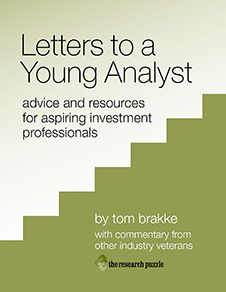
- Wednesday, January 27th, 2010
- stuck in one dimension
-
While there tends to be a right size of things beyond which problems seem to occur,The Reformed Broker | Which was the “In 2009, I learned that . . .” lesson that I shared in this compilation by Joshua Brown. there is also a right scope of things. As with individuals, organizations struggle with the question of how specialized versus how generalized they should be in their efforts. Personally, we often know if the fit is bad (“a square peg in a round hole”), but in aggregating our efforts it is more difficult to optimize our approach.
There are certainly errors that are made by being spread too thin. In my own case, I think that my roles as a consultant, advisor, and writer work off of each other in a way that yields benefits for my clients, but there are days when I wonder if I’m getting the equation wrong. As for firms, we need look no further than the “financial supermarkets” of yore (for a time, I was a cog in one of the many wheels of a prime example) to see that trying to be all things to all people can damage the firm as well as the people that work for it and invest with it.
The topic today is the opposite case, and as an example we’ll look at the world of golf. In August, I wrote a piece about the Accenture advertisements that featured Tiger Woods and my take on the “competitive keys” that they illustrated.the research puzzle | The posting, linked here, was written in advance of the PGA at Hazeltine, which turned out to be the first time Woods lost a major championship when holding the lead entering the final round. The link from my posting to the Accenture ads no longer works, for obvious reasons. As was clear years ago to anyone familiar with the structure of the PGA Tour, there was only one golfer that really mattered. Everything revolved around Woods and everything was based upon Woods. An entire economic edifice, inside and outside of the tour, was built upon his ever-broadening shoulders.
It worked until it didn’t. While few could have written the script as to how it would unwind, since the specific risk that caused the blowup wasn’t widely known (they rarely are), the conditions were ripe for a reversal of fortune. In this case, the golf world had a taste of life without its Tiger the year before, when he was injured. (Bottom line: Golf was injured too.) While it would be foolish to count such a great player out going forward, there’s no doubt that everything has changed, and that the one person who was holding at bay all of the weaknesses in the structure of the sport can’t do it anymore.
Such is the nature of a star system. The similarity to the world of investment management is easy to see. Firms have a hard time resisting the concentration that comes from riding a successful strategy or a successful manager. One thinks of Janus during the go-go years, ever more invested in a philosophy, with the huge cash flows plowed into that way of thinking (and the archetypal stocks of the time). More recently, the soap opera involving TCW and Jeffrey Gundlach is but the latest example of the lurking hazards if an investment firm is dominated by one personality. The list of similar situations is very long indeed, if lacking in some of the juicier bits of the back-and-forth lawsuits that have been filed in that particular case.
Day to day, it’s easy to get similarly trapped when facing investment decisions. If you have your rally cap on, it’s hard to see the negatives cropping up, just as positive possibilities are obscured if there is a bearish haze that clouds your view. You could have a paired trade on and think of yourself as market neutral, but if both the long and the short represent your world view, all you are is leveraged to your belief system.
It’s a fine line to walk, since having the strength of your convictions is important, as is making the most of the things you do best. But when you fall in love with a narrow approach, especially if it’s what’s working now, you can lose sight of many of the clues that matter. Consciously looking for the other side of things should be an integral part of your decision processes.
Even the unthinkable happens now and again. Inching away from a perceived winner rather than being increasingly attracted to the light of success is prudent risk management. But it’s very hard to do.
